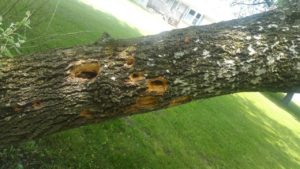In the Grow (Q & A)
The following question and answer columns are currently written by B. Rosie Lerner, Purdue Consumer Horticulture Extension Specialist and are distributed to news media around the state by the Purdue University Agricultural Communications. Columns from June 1995 - January 2006 were authored by Bev Shaw, Advanced Master Gardener.
Ornamental Pear Fallout
Q: I’ve attached pictures of the only tree we have on our property. Because it is our only tree, I am deeply concerned with the possibilities of irreparable damage to it. As you can see, one of the branches broke off during a November windstorm. Unfortunately, that left a bare gap on the trunk. Please let me know how to treat this damaged area so no further damage is done to it and tell me […]
Early spring pruning will tame this hydrangea
Q: I have a hydrangea that is overgrown. It’s falling over and is too tall and wide. I would like it not to block the window. But I don’t know how/when/how much to prune to a smaller size. — T.B., Morgan County A: Pruning time and technique depends on the particular species of hydrangea. Yours appears to be the panicle hydrangea, Hydrangea paniculata. Panicle hydrangea blooms on new wood, meaning the flower buds are produced on new […]
Timing of hydrangea pruning varies by species
Q: Attached is a photo of our current hydrangea plant in front of our house. Should I cut it back now or leave it alone until spring? Or do you think it’s a lost plant? – R.G., Henry County, Indiana A: A number of hydrangea species are grown in Indiana. The proper time of pruning depends on the species. Your photo appears to be Hydrangea quercifolia, more commonly known as oakleaf hydrangea, one of our […]
Pretty ground cover? Probably a weed
Q: I’m having an argument with my wife about a plant in our yard, and we hope you can help arbitrate. I’ve sent a photo of a plant that we found growing near some shrubs. Neither of us remember planting it. My wife thinks it’s pretty ground cover and that we should let it stay. I think it’s a weed and that we should get it out of there before it takes over the whole […]
In The Grow Question and Answer – High winds can be tough on trees
Q. Can you tell me what kind of tree this is? They were planted near our community lake 25 years ago. K.M., Indianapolis A. This is a honey locust tree, known botanically as Gleditsia triacanthos. The species is native to the eastern US. It has large seed pods and trunks that are armed with wicked thorns. Fortunately, most plants sold for landscape specimens are cultivars that are both seedless and thornless. But even these improved […]
Gardeners worn down; clearweed may be culprit
Q: I have had a garden on our property for about 14 years. Naturally, we’ve always had to deal with weeds, but until last year they had been the usual crabgrass and other types that could be controlled if you kept ahead of them. But last year, some type of weed or ground cover has sprung up, and it’s infuriating!! There is absolutely no way to weed it out by hand because it comes up almost […]
Pussy willow shrubs can thrive in well-drained soil
Q: I am writing about a pussy willow tree I planted in my backyard in early August 2018. I have wanted one for some time and found one on sale at a discount department store. It didn’t have much info on what it takes to grow by ponds or lakes. So, if you could give me any information, it would be appreciated. A: A number of willow shrub species are commonly called pussy willows, so […]
Blue spruce not a great choice for Hoosiers
Q: We have 5.5 acres with several hundred white pines, 7 blue spruce, and 2 red pines. Several of the blue spruce are dying. Several years ago, two started dying from the bottom up. We put evergreen spikes around them, and after a year or so they came back to normal. Presently some of the large ones are now dying from the bottom to the top. We put spikes around two large and one small, […]
Gaping wounds likely a woodpecker’s work
Q. I saw these holes in my tree and am wondering what they are from. This tree is the only one I have seen them on. – M.S., Chesterton Some species of woodpeckers cause large holes in tree trunks. A. The holes are likely from woodpecker injury, but the tree may have some other issues. Has the tree been in a state of decline for a while? Perhaps branch dieback, leaf drop or other symptoms? […]
Eastern Red Cedars Volunteer Way Too Often
Q. I am wondering what you might know about the small “red cedar trees” that seem to be invading fencerows and highways, especially U.S. 31 north of Kokomo. I think a column from you would be worthwhile, since I can`t seem to get my neighbors to control the “pretty little trees,” which are much like Canadian thistle and kudzu. — E.W., Kokomo A. The eastern red cedar is a juniper, rather than a true cedar. Known […]









